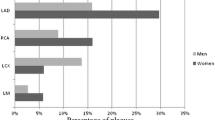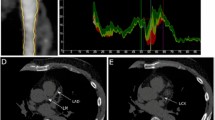Abstract
Increasing coronary artery calcium scores (CACS) are independently associated with cardiac events. Recent advents in coronary computed tomography angiography (CCTA) have allowed us to better characterize individual plaque. Currently, it is unknown if higher CACS are likely to be associated with more calcified or mixed and heterogeneous plaque burden on CCTA. The study population consisted of 1,043 South Korean asymptomatic subjects (49 ± 10 years, 62% men) who underwent CCTA (64-slice MDCT). Plaques were classified on contrast-enhanced CCTA as non-calcified, mixed, and calcified on a per-segment basis according to the modified American Heart Association classification. The majority of the study participants had no coronary calcification (n = 866, 83%), whereas CACS> 0 was observed in 177 participants (17%). Only 40 (5%) participants in absence of CACS had exclusively non-calcified plaque, whereas 10 (1.2%) had significant coronary artery disease. With increasing CACS, study participants were more likely to have exclusively mixed or combination atherosclerotic plaques (P = 0.001). Among individuals with CACS 1–10, the prevalence of at least two coronary segments with mixed plaques was 4%, increasing up to 18 and 41% with CACS of 11–100 and >100. The respective prevalence of ≥2 coronary segments (calcified plaques) with increasing CACS were 6%, 16 and 26% (P = 0.01) and of non-calcified plaques were 6%, 6 and 11% (P = 0.71). In multivariable adjusted analyses, those with CACS >100 were 7.17 times (95% CI: 1.36–37.68) more likely to have ≥2 coronary segments with calcified plaque comparing with CACS 1–10. On the other hand the respective risk was higher for presence of ≥2 segments with mixed plaques (odds ratio: 15.81, 95% CI: 3.14–79.58). Absence of CAC is associated with a negligible presence of any atherosclerotic disease as detected by CCTA in asymptomatic population. A higher CACS is more likely to be associated with heterogeneous coronary plaque (combination of calcified, non-calcified, and mixed plaques), and appears to be more strongly associated with a higher burden of mixed plaque.



Similar content being viewed by others
Abbreviations
- CACS:
-
Coronary artery calcium scores
- CTA:
-
Coronary CT angiography
References
Budoff MJ, Achenbach S, Blumenthal RS, Carr JJ, Goldin JG, Greenland P, Guerci AD, Lima JA, Rader DJ, Rubin GD, Shaw LJ, Wiegers SE (2006) Assessment of coronary artery disease by cardiac computed tomography: a scientific statement from the American heart association committee on cardiovascular imaging and intervention, council on cardiovascular radiology and intervention, and committee on cardiac imaging, council on clinical cardiology. Circulation 114:1761–1791
Greenland P, Bonow RO, Brundage BH, Budoff MJ, Eisenberg MJ, Grundy SM, Lauer MS, Post WS, Raggi P, Redberg RF, Rodgers GP, Shaw LJ, Taylor AJ, Weintraub WS (2007) ACCF/AHA 2007 clinical expert consensus document on coronary artery calcium scoring by computed tomography in global cardiovascular risk assessment and in evaluation of patients with chest pain: a report of the American College of Cardiology Foundation Clinical Expert Consensus Task Force (ACCF/AHA Writing Committee to Update the 2000 Expert Consensus Document on Electron Beam Computed Tomography) developed in collaboration with the society of atherosclerosis imaging and prevention and the society of cardiovascular computed tomography. J Am Coll Cardiol 49:378–402
Sangiorgi G, Rumberger JA, Severson A, Edwards WD, Gregoire J, Fitzpatrick LA, Schwartz RS (1998) Arterial calcification and not lumen stenosis is highly correlated with atherosclerotic plaque burden in humans: a histologic study of 723 coronary artery segments using nondecalcifying methodology. J Am Coll Cardiol 31:126–133
Rumberger JA, Simons DB, Fitzpatrick LA, Sheedy PF, Schwartz RS (1995) Coronary artery calcium area by electron-beam computed tomography and coronary atherosclerotic plaque area. A histopathologic correlative study. Circulation 92:2157–2162
Johnson RC, Leopold JA, Loscalzo J (2006) Vascular calcification: pathobiological mechanisms and clinical implications. Circ Res 99:1044–1059
Leber AW, Knez A, von Ziegler F, Becker A, Nikolaou K, Paul S, Wintersperger B, Reiser M, Becker CR, Steinbeck G, Boekstegers P (2005) Quantification of obstructive and nonobstructive coronary lesions by 64-slice computed tomography: a comparative study with quantitative coronary angiography and intravascular ultrasound. J Am Coll Cardiol 46:147–154
Lin F, Shaw LJ, Berman DS, Callister TQ, Weinsaft JW, Wong FJ, Szulc M, Tandon V, Okin PM, Devereux RB, Min JK (2008) Multidetector computed tomography coronary artery plaque predictors of stress-induced myocardial ischemia by SPECT. Atherosclerosis 197:700–709
Pundziute G, Schuijf JD, Jukema JW, Boersma E, de Roos A, van der Wall EE, Bax JJ (2007) Prognostic value of multislice computed tomography coronary angiography in patients with known or suspected coronary artery disease. J Am Coll Cardiol 49:62–70
Pundziute G, Schuijf JD, Jukema JW, Decramer I, Sarno G, Vanhoenacker PK, Reiber JH, Schalij MJ, Wijns W, Baz JJ (2008) Head-to-head comparison of coronary plaque evaluation between multislice computed tomography and intravascular ultrasound radiofrequency data analysis. J Am Coll Cardiol Int 1:176–182
Haberl R, Becker A, Leber A, Knez A, Becker C, Lang C, Bruning R, Reiser M, Steinbeck G (2001) Correlation of coronary calcification and angiographically documented stenoses in patients with suspected coronary artery disease: results of 1,764 patients. J Am Coll Cardiol 37:451–457
Budoff MJ, Diamond GA, Raggi P, Arad Y, Guerci AD, Callister TQ, Berman D (2002) Continuous probabilistic prediction of angiographically significant coronary artery disease using electron beam tomography. Circulation 105:1791–1796
Choi EK, Choi S, Rivera JJ, Nasir K, Chang SA, Chun EJ, Kim HK, Choi DJ, Blumenthal RS, Chang HJ (2008) Coronary CT angiography as a screening tool for the detection of occult coronary artery disease in asymptomatic individuals. J Am Coll Cardiol 52:357–365
Austen WG, Edwards JE, Frye RL, Gensini GG, Gott VL, Griffith LS, McGoon DC, Murphy ML, Roe BB (1975) A reporting system on patients evaluated for coronary artery disease, report of the Ad hoc committee for grading of coronary artery disease, council on cardiovascular surgery, American Heart Association. Circulation 51:5–40
Leber AW, Becker A, Knez A, von Ziegler F, Sirol M, Nikolaou K, Ohnesorge B, Fayad ZA, Becker CR, Reiser M, Steinbeck G, Boekstegers P (2006) Accuracy of 64-slice computed tomography to classify and quantify plaque volumes in the proximal coronary system: a comparative study using intravascular ultrasound. J Am Coll Cardiol 47:672–677
Cheruvu PK, Finn AV, Gardner C, Caplan J, Goldstein J, Stone GW, Virmani R, Muller JE (2007) Frequency and distribution of thin-cap fibroatheroma and ruptured plaques in human coronary arteries: a pathologic study. J Am Coll Cardiol 50:940–949
Farb A, Burke AP, Tang AL, Liang TY, Mannan P, Smialek J, Virmani R (1996) Coronary plaque erosion without rupture into a lipid core. A frequent cause of coronary thrombosis in sudden coronary death. Circulation 93:1354–1363
Huang H, Virmani R, Younis H, Burke AP, Kamm RD, Lee RT (2001) The impact of calcification on the biomechanical stability of atherosclerotic plaques. Circulation 103:1051–1056
Shanahan CM (2007) Inflammation ushers in calcification: a cycle of damage and protection? Circulation 116:2782–2785
Nadra I, Mason JC, Philippidis P, Florey O, Smythe CD, McCarthy GM, Landis RC, Haskard DO (2005) Proinflammatory activation of macrophages by basic calcium phosphate crystals via protein kinase C and MAP kinase pathways: a vicious cycle of inflammation and arterial calcification? Circ Res 96:1248–1256
Nakamura M, Nishikawa H, Mukai S, Setsuda M, Nakajima K, Tamada H, Suzuki H, Ohnishi T, Kakuta Y, Nakano T, Yeung AC (2001) Impact of coronary artery remodeling on clinical presentation of coronary artery disease: an intravascular ultrasound study. J Am Coll Cardiol 37:63–69
Beckman JA, Ganz J, Creager MA, Ganz P, Kinlay S (2001) Relationship of clinical presentation and calcification of culprit coronary artery stenoses. Arterioscler Thromb Vasc Biol 21:1618–1622
Weiss RM (2001) Another calcium paradox? Arterioscler Thromb Vasc Biol 21:1561–1562
Gottlieb I, Lima JA (2008) Screening high-risk patients with computed tomography angiography. Circulation 117:1318–1332 Discussion 1332
Detrano R, Guerci AD, Carr JJ, Bild DE, Burke G, Folsom AR, Liu K, Shea S, Szklo M, Bluemke DA, O’Leary DH, Tracy R, Watson K, Wong ND, Kronmal RA (2008) Coronary calcium as a predictor of coronary events in four racial or ethnic groups. N Engl J Med 358:1336–1345
Abedin M, Tintut Y, Demer LL (2004) Vascular calcification: mechanisms and clinical ramifications. Arterioscler Thromb Vasc Biol 24:1161–1170
Ehara S, Kobayashi Y, Yoshiyama M, Shimada K, Shimada Y, Fukuda D, Nakamura Y, Yamashita H, Yamagishi H, Takeuchi K, Naruko T, Haze K, Becker AE, Yoshikawa J, Ueda M (2004) Spotty calcification typifies the culprit plaque in patients with acute myocardial infarction: an intravascular ultrasound study. Circulation 110:3424–3429
Schmid M, Pflederer T, Jang IK, Ropers D, Sei K, Daniel WG, Achenbach S (2008) Relationship between degree of remodeling and CT attenuation of plaque in coronary atherosclerotic lesions: an in vivo analysis by multi-detector computed tomography. Atherosclerosis 197:457–464
Pohle K, Achenbach S, Macneill B, Ropers D, Ferencik M, Moselewski F, Hoffmann U, Brady TJ, Jang IK, Daniel WG (2007) Characterization of non-calcified coronary atherosclerotic plaque by multi-detector row CT: comparison to IVUS. Atherosclerosis 190:174–180
Pflederer T, Schmid M, Ropers D, Ropers U, Komatsu S, Daniel WG, Achenbach S (2007) Interobserver variability of 64-slice computed tomography for the quantification of non-calcified coronary atherosclerotic plaque. Rofo 179:953–957
Becker CR, Nikolaou K, Muders M, Babaryka G, Crispin A, Schoepf UJ, Loehrs U, Reiser MF (2003) Ex vivo coronary atherosclerotic plaque characterization with multi-detector-row CT. Eur Radiol 13:2094–2098
Marwan M, Ropers D, Pflederer T, Daniel WG, Achenbach S (2009) Clinical characteristics of patients with obstructive coronary lesions in the absence of coronary calcification: an evaluation by coronary CT angiography. Heart 95:1056–1060
Kitagawa T, Yamamoto H, Horiguchi J et al (2009) Characterization of noncalcified coronary plaques and identification of culprit lesions in patients with acute coronary syndrome by 64-slice computed tomography.JACC. Cardiovasc imaging 2(2):153–160
Feuchtner G, Postel T, Weidinger F et al (2008) Is there a relation between non-calcifying coronary plaques and acute coronary syndromes? A retrospective study using multislice computed tomography. Cardiology 110(4):241–248
Hoffmann U, Bamberg F, Chae CU (2009) Coronary computed tomography angiography for early triage of patients with acute chest pain. The ROMICAT (Rule Out Myocardial Infarction using Computer Assisted Tomography) trial. J Am Coll Cardiol 53:1642–1650
Author information
Authors and Affiliations
Corresponding author
Rights and permissions
About this article
Cite this article
Nasir, K., Rivera, J.J., Yoon, Y.E. et al. Variation in atherosclerotic plaque composition according to increasing coronary artery calcium scores on computed tomography angiography. Int J Cardiovasc Imaging 26, 923–932 (2010). https://doi.org/10.1007/s10554-010-9625-0
Received:
Accepted:
Published:
Issue Date:
DOI: https://doi.org/10.1007/s10554-010-9625-0




